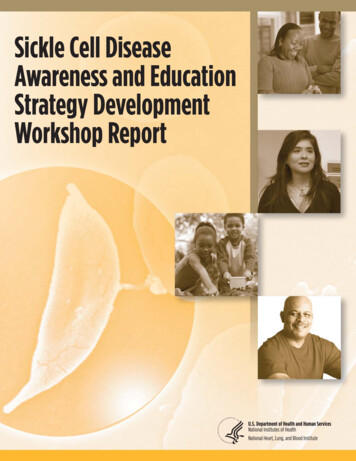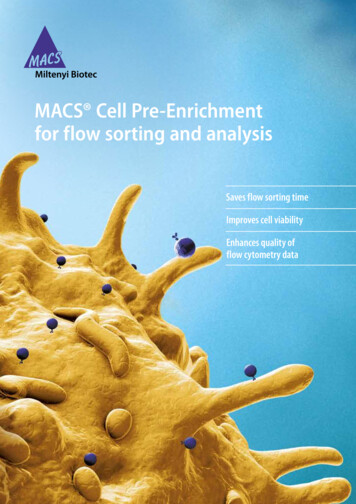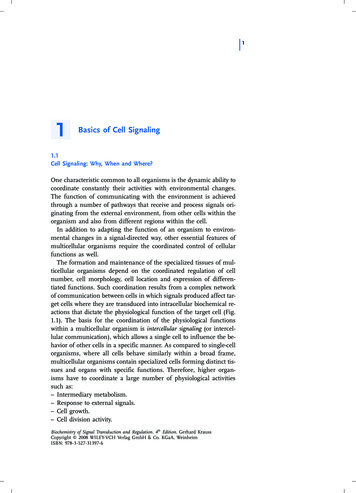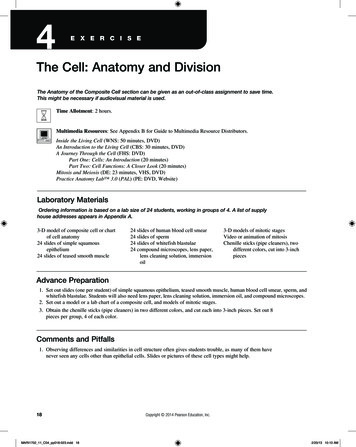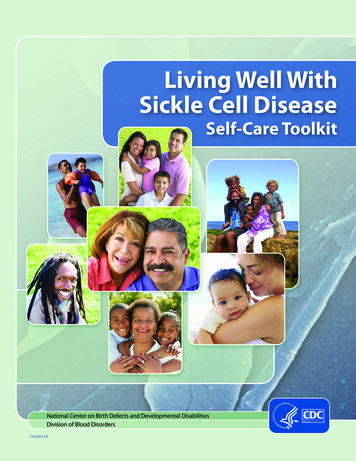
Transcription
Living Well WithSickle Cell DiseaseSelf-Care ToolkitNational Center on Birth Defects and Developmental DisabilitiesDivision of Blood DisordersCS226674-B
ContentsIntroduction. 1What Is the Living Well With Sickle Cell Disease: Self- Care Toolkit?.1Why Should I Use the Living Well With Sickle Cell Disease: Self-Care Toolkit?.1Section 1: Sickle Cell Disease 101.2What Is Sickle Cell Disease?.2What Causes Sickle Cell Disease?. 2Who Is Affected by Sickle Cell Disease?.2What Health Problems Does Sickle Cell Disease Cause?. 3How Is Sickle Cell Disease Treated?.3Is There a Cure for Sickle Cell Disease?.3Section 2: Living Well With Sickle Cell Disease.4Six Steps to Living Well With Sickle Cell Disease.4Five Tips to Help Prevent Infections. 5Emergency Guide: When to See the Doctor.6Coping With Stress. 7Fifteen Reasons Why Exercise Is Good.9Section 3: Tools for Managing Your Health.10Where Can I Find and Print the Forms for My Self-Care Toolkit?. 10How Often Should I Update the Information in My Self-Care Toolkit?. 10Who Should Know About My Self-Care Toolkit?. 10Living Well With Sickle Cell Disease Self-Care ToolkitContents–i
Forms. 111. Developing S.M.A.R.T GOALS.122. Healthy Behavior Contract. 133. Personal /Family Contact Information Sheet. 144. Medical Emergency Information Sheet.155. Specialty Care Information Sheet.176. Medical Appointment Sheet. 187. Pharmacy Provider Information Sheet. 198. Insurance Information Sheet. 209. Medication Log Sheet.2110. Vaccination and Immunization Tracking Sheet.2211. Hospitalization and Surgical Procedures Tracking Sheet. 2312. Transfusion Tracking Sheet. 2413. Laboratory Testing Sheet.2514. Additional Testing Tracking Sheet. 2615. Daily Pain Tracking Sheet.2716. Describe the Pain Sheet. 2817. Stress Diary Sheet. 2918. Daily Physical Activity Tracking Sheet. 3019. Water Intake Tracking Sheet.31Questions To Ask My Health Provider.32Notes Page.33Living Well With Sickle Cell Disease Self-Care ToolkitContents–ii
INTRODUCTIONWhat Is the Living Well With Sickle Cell Disease: Self-Care Toolkit?A toolkit is a collection of materials that can be used to help you to manage your health and keep trackof important information regarding sickle cell disease (SCD). The Living Well With Sickle Cell Disease:Self-Care Toolkit has multiple uses. It is designed to help you and your caregivers with managementof your disease, medical care, services, and health providers. The toolkit also will help communicationbetween the many health providers and service providers that are involved with patient care.Why Should I Use the Living Well With Sickle Cell Disease:Self-Care Toolkit?Because many doctors are not familiar with SCD, it is very important for you to take an active role inmanaging your own care. To make important decisions, you need to know about SCD, understandyour treatment options, and then make the best possible choices for your health. Using the toolsprovided in this toolkit will help you to monitor your health care and manage your disease. Puttingtogether a care notebook or binder that you can take with you wherever and whenever (for exampledoctor’s appointments, emergency room visits, vacation, and the workplace) you need it will helpyou organize all of your SCD-related medical information in one place so that you can keep track ofinformation over time.You might want to include the following: Doctor contact information. Medical appointments. Changes in medications or treatments. Test results. Vaccination and immunization (shots) records. Community resources. Any other information about your condition (facts found on the Internet, in brochures, and fromany other sources of information and support).By organizing all of your SCD-related information in one place, you can: Actively take part in, and advocate for, your own care. Work together with the doctors on your medical team. Remember new and complex information that is hard to process (when the doctor first tells youabout a condition, if the condition worsens, or when treatment changes). If you are a teenager or young adult with SCD, you can begin to take responsibility for your ownhealth history and information.Living Well With Sickle Cell Disease Self-Care ToolkitIntroduction–1
Section 1:Sickle Cell Disease 101What Is Sickle Cell Disease?Sickle cell disease (SCD) is a group of inherited red blood cell disorders. Healthy red blood cells are round and they move through small blood vessels carrying oxygen toall parts of the body. For someone with SCD, the red blood cells become hard and sticky and look like a C-shaped farmtool called a “sickle”. Sickle cells die early in comparison to non- sickle cells, which causes a constant shortage of redblood cells. Sickle cells can get stuck in small blood vessels and block the flow of blood and oxygen to organsin the body. These changes in cells can cause repeated episodes of severe pain, organ damage,serious infections, or even stroke.What Causes Sickle Cell Disease?SCD is inherited in the same way that people get the color of their eyes, skin, and hair. A person with SCD is born with it. People cannot “catch” SCD from being around a person who has it.Who Is Affected by Sickle Cell Disease? It is estimated that SCD affects 90,000 to 100,000 people in the United States, mainly Blacks orAfrican Americans. The disease occurs among about 1 of every 500 Black or African-American births and among about1 of every 36,000 Hispanic-American births. SCD affects millions of people throughout the world and is particularly common among thosewhose ancestors come from sub-Saharan Africa; regions in the Western Hemisphere (SouthAmerica, the Caribbean, and Central America); Saudi Arabia; India; and Mediterranean countriessuch as Turkey, Greece, and Italy.Living Well With Sickle Cell Disease Self-Care ToolkitSection 1: Sickle Cell Disease 101–2
What Health Problems Does Sickle Cell Disease Cause?The following are some of the most common complications of SCD:Pain Episodes or Crises—Sickle cells don’t move easily through small blood vessels and can getstuck and clog blood flow. This causes pain that can start suddenly, be mild to severe, and last forany length of time.Infection—People with SCD, especially infants and children, are more likely to experience harmfulinfections such as influenza, meningitis (infection of the brain or spinal cord), and hepatitis (infectionof the liver).Hand–Foot Syndrome—Swelling in the hands and feet, often along with a fever, is caused by thesickle cells getting stuck in the blood vessels and blocking the blood from flowing freely throughthe hands and feet.Eye Disease—SCD can affect the blood vessels in the eye and lead to long-term damage.Acute Chest Syndrome—Blockage of the flow of blood to the lungs can cause acute chest syndrome(ACS). ACS is similar to pneumonia; symptoms include but are not limited to chest pain, coughing,difficulty breathing, and fever. It can be life threatening and should be treated in a hospital.Stroke—Sickle cells can clog blood flow to the brain and cause a stroke. A stroke can result in lifelongdisabilities and learning problems.How Is Sickle Cell Disease Treated?The goals of treating SCD are to relieve pain and to prevent infections, eye damage, and strokes.There is no single best treatment for all people with SCD. Treatment options are different for eachperson depending on the symptoms. Treatments can include receiving blood transfusions, receivingintravenous therapy (fluids given into a vein), and medications to help with pain. For severe SCD, a medicine called hydroxyurea might be recommended. Research suggests thathydroxyurea can reduce the number of painful episodes and the recurrence of ACS. It also canreduce hospital stays and the need for blood transfusions among adults who have SCD.Is There a Cure for Sickle Cell Disease?To date, the only cure for SCD is a bone marrow or stem cell transplant. A bone marrow or stem cell transplant is a procedure that takes healthy stem cells from a donorand puts them into someone whose bone marrow is not working properly. These healthy stemcells cause the bone marrow to make new, healthy cells. Bone marrow or stem cell transplants are very risky, and can have serious side effects, includingdeath. For the transplant to work, the bone marrow must be a close match.Living Well With Sickle Cell Disease Self-Care ToolkitSection 1: Sickle Cell Disease 101–3
Section 2:Living Well With Sickle Cell DiseaseSix Steps to Living Well With Sickle Cell DiseaseYou can live a full life and enjoy most of the activities that other people do. The following tips will helpyou stay as healthy as possible:Find good medical care—Sickle cell disease is a complex disease. Good quality medical care fromdoctors and nurses who know a lot about the disease can help prevent some serious problems. Often,the best choice is a hematologist (a doctor who specializes in blood diseases) working with a team ofspecialists.Get regular checkups—Regular health checkups with a primary care doctor can help prevent someserious problems.Prevent infections—Common illnesses, like influenza, quickly can become dangerous for a personwith SCD. The best defense is to take simple steps like washing your hands frequently to help preventinfections. See “Five Tips to Help Prevent Infection” for more information.Learn healthy habits—Drinking 8 to 10 glasses of water every day and eating healthy food willhelp to maintain hydration and proper nutrition. People with SCD should maintain a balanced bodytemperature, getting neither too hot nor too cold. Participating in physical activity to help stay healthy isvery important. However, it’s essential that you don’t overdo it, rest when tired, and drink plenty of water.Look for clinical studies—New clinical research studies occur frequently and these studies might giveyou access to new medicines and treatment options.Get support—Find a patient support group or community-based organization that can provideinformation, assistance, and support.Living Well With Sickle Cell Disease Self-Care ToolkitSection 2: Living Well With Sickle Cell Disease–4
Five Tips To Help Prevent InfectionsCommon illnesses, like influenza quickly can become dangerous for a person with SCD.The best defense is to take simple steps to help prevent infections.1. Vaccines—Vaccines are a great way to prevent many serious infections. Adults and childrenwith SCD should have the influenza vaccine every year, as well as the pneumococcal vaccineand any others recommended by their doctor.2. Penicillin—Penicillin can help prevent infections. Children with SCD should take penicillin (oranother antibiotic prescribed by a doctor) every day until they are at least 5 years of age.3. Washing hands—Washing your hands is one of the best ways to help prevent getting aninfection. People with SCD, their families, and other caretakers should wash their hands withsoap and clean water many times each day. If you don’t have access to soap and water, youcan use gel hand cleaners with alcohol in them.Wash your hands before Making food. Eating.Wash your hands after Using the bathroom. Blowing your nose, coughing, or sneezing. Shaking hands. Touching people or things that can carry germs, such as:»» Diapers or a child who has used the toilet.»» Food that has not been cooked (raw meat, raw eggs, or unwashed vegetables).»» Animals or animal waste.»» Trash.»» A person who is sick.4. Food Safety—Salmonella, a type of bacterium in some foods, can be especially harmfulto children with SCD. To avoid exposure to this and other bacteria and to stay safe whencooking and eating: Wash your hands, cutting boards, counters, knives, and other utensils after theytouch uncooked foods. Wash vegetables and fruit well before eating them. Cook meat until it’s well done. The juices should run clear and there should beno pink inside.Living Well With Sickle Cell Disease Self-Care ToolkitSection 2: Living Well With Sickle Cell Disease–5
Do not eat raw or undercooked eggs. Raw eggs might be “hiding” in homemade hollandaisesauce, Caesar and other homemade salad dressings, tiramisu, homemade ice cream,homemade mayonnaise, cookie dough, and frostings. Do not eat raw or unpasteurized milk or other dairy products (cheeses). Make sure thesefoods have a label that says they are “pasteurized”.5. Avoid Reptiles—Salmonella (mentioned previously) is present in some reptiles and can beespecially harmful to people with SCD. Make sure children and adults stay away from turtles,snakes, and lizards.Emergency Guide: When To See the DoctorIt is very important that every person with SCD have a plan for how to get help immediately—at anyhour—if there is a problem. Be sure to find a medical facility that will have access to your medicalrecords or keep a copy that you can bring.Go to an emergency room or urgent care facility right away for: Fever above 101 F. Difficulty breathing. Chest pain. Abdominal (belly) swelling. Severe headache. Sudden weakness or loss of feeling and movement. Seizure. Painful erection of the penis that lasts more than 4 hours.Call a doctor right away for: Pain anywhere in the body that will not go away with treatment at home. Any sudden problem with vision.Living Well With Sickle Cell Disease Self-Care ToolkitSection 2: Living Well With Sickle Cell Disease–6
Coping With StressThe BasicsPreventing and managing stress can help lower your risk of serious health problems associated with SCD.You can prevent or lessen stress by: Planning ahead. Preparing for stressful events.Some stress is hard to avoid. You can find ways to manage stress by: Recognizing when you feel stressed. Taking time to relax. Getting active and eating healthy. Sharing your feelings with friends and family.What Are the Signs of Stress?When people are under stress, they might feel: Worried. Irritable. Depressed. Unable to focus.Stress also affects the body. Physical signs of stress include: Headaches. Back pain. Problems sleeping. Stomach upset. Weight gain or loss. Tense muscles. Frequent or more serious colds.Living Well With Sickle Cell Disease Self-Care ToolkitSection 2: Living Well With Sickle Cell Disease–7
What Causes Stress?Stress often is caused by some type of change. Even positive changes, like marriage or a job promotion,can be stressful. Stress can be short term or long term.Common Causes of Short-Term Stress Having too much to do and not much time. Having lots of little problems on the same day (like encountering a traffic jam or running late). Getting lost. Having an argument.Common Causes of Longer Term Stress Relationship issues. Death of a loved one. Illness. Caring for someone who is sick. Problems at work. Money problems.What are the benefits of managing stress?Managing stress can help you: Sleep better. Control your weight. Get sick less often and heal faster. Lessen neck and back pain. Be in a better mood. Get along better with family and friendsTake Action!Being prepared and in control of your condition will help you feel less stress. Follow these six tips toprevent and manage stress.Plan your time—Think ahead about how you are going to use your time. Write a to-do list anddecide which tasks are the most important. Be realistic about how long each task will take.Relax with deep breathing—Take part in deep breathing activities or yoga classes.Living Well With Sickle Cell Disease Self-Care ToolkitSection 2: Living Well With Sickle Cell Disease–8
Relax your muscles— Try stretching or taking a hot shower to help you relax. Stress causes tensionin your muscles.Get moving—Plan physical activity to help prevent and manage stress. It also can help relax yourmuscles and improve your mood. Before you start, be sure to discuss any new exercise routinewith your doctor. Aim for 2 hours and 30 minutes a week of moderate aerobic activity (e.g. walking or biking). Be sure to exercise for at least 10 minutes at a time. Do strengthening activities (like sit-ups or lifting weights) at least 2 days a week.Share your feelings with friends and family—Tell your friends and family if you are feeling stressed.They might be able to help.Get help if you need it—Find help if your stress doesn’t go away or keeps getting worse.Fifteen Reasons Why Exercise Is GoodBeing physically active can help with maintaining overall good health. The following areexamples of the benefits of exercising:99 Helps to improve and maintain good overall health.99 Strengthens the cardiovascular system—heart, lungs and blood vessels99 Reduces the risk of persistent illness.99 Increases muscle strength.99 Improves flexibility.99 Increases endurance and stamina.99 Increases natural pain killers (called endorphins) in the body’s nervous system, which helpcontrol pain.99 Helps with weight control.99 Helps to improve quality of sleep.99 Helps balance and coordination.99 Reduces fatigue and increases energy.99 Reduces muscular tension, stress, and depression.99 Helps combat depression and anxiety.99 Helps you maintain a positive outlook.99 Helps to prevent constipation.Living Well With Sickle Cell Disease Self-Care ToolkitSection 2: Living Well With Sickle Cell Disease–9
Section 3:Tools for Managing Your HealthWhere Can I Find and Print the Forms for My Self-Care Toolkit?The Living Well With Sickle Cell Disease: Self-Care Toolkit includes several forms that you can use tokeep track of important information, manage your health, and monitor your medical care. You can printcopies of these forms, which are available at w Often Should I Update the Information in My Self-Care Toolkit?To be most helpful, your Self-Care Toolkit should provide a snapshot of your current health status. Besure to include new prescriptions and treatment information. Once every few months, you might wantto go through your toolkit and remove or file certain sectionsif they are getting too large or you find you no longer need them.Who Should Know About My Self-Care Toolkit?You should make sure that a family member or other caregiver knows that you have a Self-Care Toolkit.You also should make sure that they can find it in an emergency and bring it to the clinic or hospitalwhere you are receiving care.Living Well With Sickle Cell Disease Self-Care ToolkitSection 3: Tools for Managing Your Health–10
FORMSLiving Well With Sickle Cell Disease Self-Care ToolkitForms–11
ultimate goalShort-Term4321Create goals thatmotivateExample: I will increase myexercise to 4 times per weekDefine goals bynumbersExample: Progress can be shownby weekly weigh-inClearly define desiredoutcomeExample: Lose 20 poundsattainableAmeasurableMspecificSDEVELOPING S.M.A.R.T GOALSLong-Termstepping stonesLiving Well With Sickle Cell Disease Self-Care ToolkitForms–12Example: I will cut back onsugary foodsSet challenging butrealistic goalsrealisticRExample: Lose 2 pounds perweek for 10 weeksSet deadlines foraccomplishmentstime-frameT
HEALTHY BEHAVIOR CONTRACTUse the goals developed on the Developing S.M.A.R.T Goals form to complete your healthy behaviorcontract. Use this contract to help you to set and attain healthy behaviors that will improve your healthand well-being.Based on an awareness of my health status, I,have decided to set the following behavior-related health goal, which will contribute to improvement ofmy personal well-being.My health behavior goal is:(long-term SMART goal)The benefits of my achieving this goal are:The anticipated problems or barriers to taking positive action are:The behaviors I will adopt to accomplish this personal health goal are:(short-term SMART goal)I will reinforce my actions by:and reward achievement of my goal byI, , have reviewed this contact and agree to be a part of apositive support system throughout this behavior change project.Signed DateI have reviewed this contract and agree to take action to accomplish my goal and to discuss the resultswith my provider, family member or friend. Upon completion of this contract, I will identify my next areaof opportunity and take further steps to improve my health status.Signed DateWitness DateProvider/Family Member/FriendLiving Well With Sickle Cell Disease Self-Care ToolkitForms–13
PERSONAL/FAMILY INFORMATION SHEETUse this form to record personal and family information in case of an emergency.YOUR NAME:DATE OF BIRTH:DIAGNOSIS:BLOOD TYPE:ADDRESS:TELEPHONE NUMBER:PARENT NAME(IF APPLICABLE):ADDRESS:TELEPHONE NUMBER:ADDITIONAL FAMILY INFORMATIONLANGUAGE SPOKEN AT HOME:OTHER LANGUAGE(S):INTERPRETER NEEDED (CIRCLE YES OR NO):Living Well With Sickle Cell Disease Self-Care ToolkitYesNoForms–14
MEDICAL EMERGENCY INFORMATION SHEETUse this form to maintain correct medical information the case of an emergency.PERSONAL INFORMATIONLast NameFirst NameDate of BirthSexMiddle InitialWeightBlood TypeCityStateZip CodePrimary InsuranceSecondary InsurancePrimary Insurance Numbers & GroupSecondary Insurance Numbers & GroupAddressSICKLE CELL DISEASE (TYPE) SS ( sickle cell anemia) SC (sickle cell hemoglobin C) S Beta ThalassemiaOtherALLERGIES None UnknownMedical Allergies:Living Well With Sickle Cell Disease Self-Care ToolkitCARDIAC NoneUnknownAnginaArrhythmiaCongestive Heart FailureCongenitalMIOtherSURGERY s–15
OTHER CHRONIC CONDITIONS NoneAsthmaBleeding atitisHIV HypertensionParalysis PsychologicalSeizuresSubstance AbuseTBUnknownOtherCURRENT MEDICATIONS None UnknownEMERGENCY CONTACT INFORMATIONPrimary Physician:Physician Telephone Number:Primary Contact Name & Relationship:Primary Contact Telephone Numbers:Secondary Contact Name & Relationship:Secondary Contact Telephone Numbers:Update information regularly! Use a separate sheet for additional information.Living Well With Sickle Cell Disease Self-Care ToolkitForms–16
SPECIALITY CARE INFORMATION SHEETUse this form to keep track of the specialty providers who are part of your medical treatment team.SPECIALTY CARE PROVIDER:DATE OF 1ST VISIT:MAILING ADDRESS:TELEPHONE /FAX NUMBER:EMAIL ADDRESS:COMMENTS:SPECIALTY CARE PROVIDER:DATE OF 1ST VISIT:MAILING ADDRESS:TELEPHONE /FAX NUMBER:EMAIL ADDRESS:COMMENTS:SPECIALTY CARE PROVIDER:DATE OF 1ST VISIT:MAILING ADDRESS:TELEPHONE /FAX NUMBER:EMAIL ADDRESS:COMMENTS:Living Well With Sickle Cell Disease Self-Care ToolkitForms–17
MEDICAL APPOINTMENT SHEET5 Steps to an effective medical appointment:99 Write down problems or questions, or both, before you go.99 Rank your questions from most important to least important.99 Share the list with your provider.99 Talk with your health care provider about options for addressing your problems or concerns.99 Speak with your provider about next steps or follow-up g Well With Sickle Cell Disease Self-Care ToolkitHEALTHPROVIDERCONTACTINFORMATIONREASON FORAPPOINTMENTWHAT WASDISCUSSED 18
PHARMACY PROVIDER INFORMATION SHEETTip: If possible use one pharmacy for all of your prescription needs. This will allow your pharmacist to keeptrack of all medications being used and the potential for interactions between medications.Use this form to keep track of all of your pharmacy providers.PHARMACY NAME:NAME OF PHARMACIST:MAILING ADDRESS:TELEPHONE /FAX NUMBER:EMAIL ADDRESS:PHARMACY NAME:NAME OF PHARMACIST:MAILING ADDRESS:TELEPHONE /FAX NUMBER:EMAIL ADDRESS:PHARMACY NAME:NAME OF PHARMACIST:MAILING ADDRESS:TELEPHONE /FAX NUMBER:EMAIL ADDRESS:PHARMACY NAME:NAME OF PHARMACIST:MAILING ADDRESS:TELEPHONE /FAX NUMBER:EMAIL ADDRESS:Living Well With Sickle Cell Disease Self-Care ToolkitForms–19
INSURANCE INFORMATION SHEETUse this form to keep track of insurance policy and identification numbers. Record contact informationfor all health insurance providers for emergency situations.PRIMARY INSURANCE:COMPANY:POLICY NUMBER:CONTACT PERSON:MAILING ADDRESS:TELEPHONE NUMBER:FAX NUMBER:EMAIL ADDRESS:MEDICAID/HMOIDENTIFICATION NUMBER:POLICY NUMBER:CONTACT PERSON:MAILING ADDRESS:TELEPHONE NUMBER:FAX NUMBER:EMAIL ADDRESS:SOCIAL SECURITY INCOMEIDENTIFICATION NUMBER:POLICY NUMBER:CONTACT PERSON:MAILING ADDRESS:TELEPHONE NUMBER:FAX NUMBER:EMAIL ADDRESS:Living Well With Sickle Cell Disease Self-Care ToolkitForms–20
MEDICATION LOG SHEETUse this form to keep track of your medication usage
Living Well With Sickle Cell Disease Self-Care Toolkit Section 2: Living Well With Sickle Cell Disease–5. Five Tips To Help Prevent Infections . Common illnesses, like influenza quickly can become dangerous for a person with SCD. The best defen

